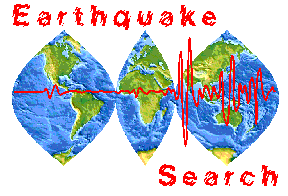
INFORMATION
INFORMATION (IEFM DTSVNWG on Screen Search): Dots are used in place of blanks to aid in the distinction between the columns. Read the sub-headers vertically.
-
Intensity (sub-header INT):
Maximum intensity on the Modified Mercalli Intensity Scale of 1931 (Wood and Neumann, 1931) or any similar 12-point intensity scale. It may also be an MMI value approximated from other intensity scales such as Ross-Forel or Japan Meteorological Agency. Possible intensity values are 1 - 9; X = 10; E = 11; T = 12.
Cultural Effects (sub-header EFF):
The most severe
effect is listed (C = Casualities; D = Damage; F =
Felt; H = Heard).
Note that casualties includes human deaths or injuries.
Domestic animal casualties are considered to
be damage.
Isoseismal Map (sub-header MAP):
(Expanded Format only)
Indicates the publication where an isoseismal map
for this event has been published.
-
U = United States Earthquakes.
E = Earthquake Notes. (Now Seismological Research Letters)
P = Preliminary Determination of Epicenters.
W = Wellington (New Zealand Seismology Reports, Wellington, N.Z.).
N = Nature Magazine.
S = Bulletin of the Seismological Society of America.
Coded as an "F" to indicate the availability of a fault plane solution in the publication, "Preliminary Determination of Epicenters, Monthly Listing".
Moment Tensor Solution (sub-header MO):
Coded as an
"G" to indicate the availability of a moment
tensor solution in the publication "Preliminary
Determination of Epicenters, Monthly Listing"
(Sipkin, 1982; Dziewonski, 1980; and Hanks and
others, 1979).
ISC Alternate Depth Indicator (sub-header DEP):
A "D" in this column indicates that a pP depth is
given, but the pP depth is not the adopted depth
in the hypocenter solution.
International Data Exchange (sub-header IDE):
An "X" in this column identifies the event as a "IDE"
earthquake.
Preferred Solution (sub-header PFD):
A "P" in this
column designates a preferred solution.
Earthquake hypocenters which are located within a
seismic network, such as Pasadena or Berkeley, or
seismic catalogs which have undergone critical
review during their compilation will be designated
as a preferred solution.
Flag (sub-header FLG): Currently not used.
PHENOMENA
-
F = Faulting.
U = Uplift.
S = Subsidence.
3 = Uplift and Subsidence.
4 = Uplift and Faulting.
5 = Faulting and Subsidence.
6 = Faulting with Uplift and Subsidence.
7 = Uplift or Subsidence.
8 = Faulting and Uplift or Subsidence.
-
T = Tsunami generated.
Q = Questionable Tsunami.
-
S = Seiche.
Q = Questionable Seiche.
-
V = Earthquake associated with
volcanism.
-
E = Explosion.
I = Collapse.
C = Coal bump or Rockburst in a coal mine.
R = Rockburst.
M = Meteoritic.
N = Either known to be or likely to be of non-tectonic origin.
? = Classified as an earthquake, but a non-tectonic origin cannot be ruled out.
V = Reservoir induced earthquake.
Guided Waves in Atmospheric And/Or Ocean: (sub-header W)
-
T = T-wave.
A = Acoustic wave.
G = Gravity wave.
B = Both A and G.
M = T-wave plus and A or G.
Miscellaneous Phenomena: (sub-header G)
-
L = Liquefaction.
G = Geyser.
S = Landslides and/or Avalanches.
B = Sandblows.
C = Ground cracks not known to be an expression of faulting.
V = Lights or other visual phenomena seen.
O = Olfactory (Unusual odors noted).
M = More than one of these phenomena observed.

